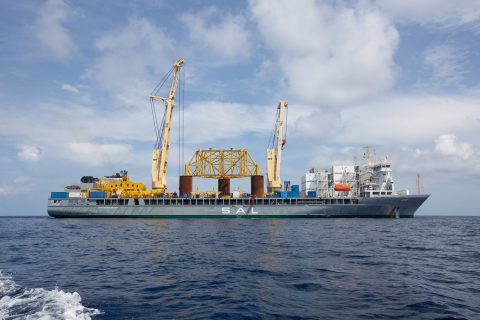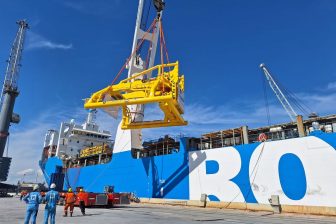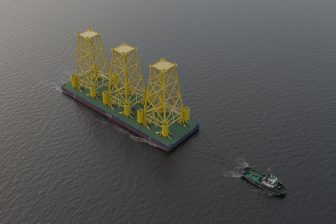
SAL develops crane extensions to meet new offshore wind demands
In response to the growing dimensions of offshore wind turbine parts, SAL Engineering and crane maker TTS-NMF have developed modular and dismountable crane boom extensions for two of SAL’s heavy-lift vessels. The so-called Fly-Jibs allow the vessels to lift higher and considerably extend their reach.
The Fly-Jibs are designed for the cranes of SAL’s Type 183 vessels and can be installed to each of their main cranes’ booms. The new piece of equipment enables the vessels to lift their crane hooks up to 70 metres in the air. The MV Lone is the first heavy-lift vessel in the SAL fleet to carry one.
The need for the Fly-Jib is caused by the growing dimensions of cargoes, especially in the wind energy industry, where transport and heavy-lift companies have to be able to lift long components vertically. SAL is currently facing such a challenge with an offshore piling project, the company states.
“Our Fly-Jib has long been on our wish list, but when a client recently approached us with the requirement to support on driving piles into the seabed for an offshore wind project, and the piles being so long that it was otherwise not possible to up-end them for installation, we saw the opportunity to realise this long term dream,” says Sune Thorleifsson, Head of Marine Project at SAL.
No small thing
SAL Engineering and crane maker TTS-NMF worked together intensively to design and develop a Fly-Jib that can suit a wide array of scopes, which led to the dismountable and modular design, the company explains.
“We worked for a long time on various designs together with TTS-NMF – the manufacturer of the cranes on our Type 183 vessels. It was essential that, in addition to having strong lifting capabilities, it could be configurable in various modes hence adding to its applicability in various working scopes,” director Karsten Behrens of SAL Engineering says.
The outcome is a Fly-Jib that can be configured in a long (23 metres) or a short (13 metres) set-up and is adjustable in three different angles. “It is designed to be interchangeable between our Type 183 vessels and can, with modifications to the existing jib, be installed on each of the cranes,” Behrens adds. It is also designed to withstand the forces occurring during a sea voyage and can be installed using only the vessels existing cranes.
“It is great to see that the concept works so well in reality and that the installation procedure of mounting the Fly-Jib onto the existing crane boom proceeded quickly and with no compromise on quality – it is no small thing that you attach,” comments Sebastian Westphal, Corporate Director Ship Management & Engineering at SAL Heavy Lift. “The lifting capabilities the vessel gains with it are tremendous. It will be used many times in the months to come during an offshore wind project and certainly in a number of projects thereafter.”
The scale increases in the offshore wind industry will be one of the key topics of the Project Cargo Summit, a two-day international conference about the transport of large and heavy cargoes, which is organised by Promedia Group on the 11th & 12th of September, 2019 in Rotterdam. Among others, Siemens Gamesa, Port of Esbjerg and Kalmar will be speakers at this young and ambitious event. For more information about this dedicated project cargo and heavy-lift event, please visit www.projectcargosummit.com.
You just read one of our premium articles free of charge
Register now to keep reading premium articles.




